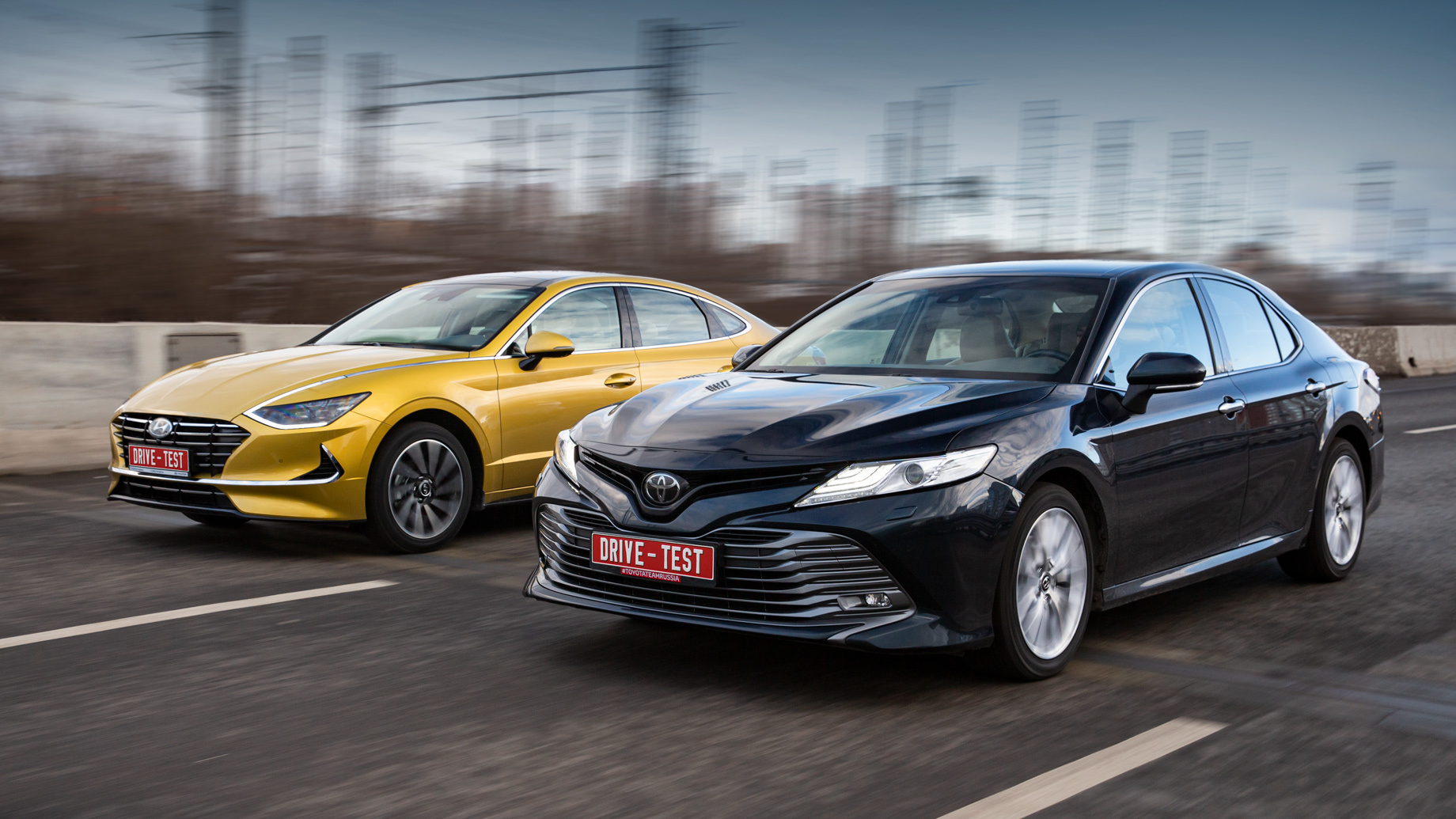The most demanded Sonata after the change of generations remains a two-liter 150-horsepower. But the top-end Sonata 2.5 Prestige (180 hp, 232 N•m) presented here turned out to be the second most popular in the entire range by the beginning of spring. Only such cars are provided by the Hyundai press park, which leaves us no freedom when choosing Toyota — we are again working with the well-known Camry 2.5 (181 hp, 231 N•m). To make the comparison correctly, we take two identical Toyotas, remove the Yokohama Ice Guard IG60 235/45 R18 non-studded tires from one and rearrange them to the Sonata.

Trim Levels and Equipment Comparison
For this test, we accepted a slight compromise in trim levels. Our Toyota Camry Safety Suite with the advanced rear seat package offers comparable equipment to the Sonata. Ideally, we would have tested the Safety Prestige trim, which costs slightly more than our Sonata.
Features the Camry Safety Suite lacks compared to the Sonata:
- Front seat ventilation
- Driver’s seat memory settings
- Blind spot monitoring system
- Electric steering column adjustment (both have mechanical)
Exclusive Features: What Each Sedan Offers
Both vehicles bring unique advantages to the table that the other simply cannot match.
Hyundai Sonata 2.5 Prestige exclusive features:
- 360-degree all-round visibility system (standard)
- Head-up display with windshield projection
- Optional panoramic sunroof
- Gradient marker lights
- Black lacquered sills
Toyota Camry 2.5 exclusive features:
- Power-adjustable rear seat backrests
- Rear side airbags
- Separate rear climate zone
- Universal control panel in the rear armrest

Target Audience: Private Owner vs. Fleet Use
The fundamental difference between these sedans lies in their intended buyer. The Sonata targets the private owner with its bold, courageous exterior design. Its styling speaks to individualist buyers rather than rear-seat passengers.
For professional or fleet use, the Camry holds clear advantages:
- Warranty coverage: Sonata limits professional drivers to 62,137 miles, with some components capped at just 12,427 miles
- Maintenance intervals: Hyundai classifies taxi use as “heavy duty,” requiring oil changes every 4,660 miles versus Camry’s 6,213-mile intervals

Interior Quality and Materials
The Camry’s interior, while functional, presents some design inconsistencies. The two-shade beige leather option makes the darker portions appear dirty. Various textures compete for attention, and buttons throughout the cabin require different pressing forces, creating a somewhat disjointed feel.
The Sonata takes a more cohesive approach with carefully selected materials and uniformly soft-clicking buttons throughout. However, the steering wheel leather deserves criticism—its sticky, rubber-like texture lacks the suppleness found in competitors like Audi or Mazda. The tightly stretched material will likely develop a glossy wear pattern over time.
Steering and Handling Characteristics
The driving experience reveals distinct personalities in each sedan.
Hyundai Sonata handling traits:
- Electric power steering feels artificially light with minimal variation
- Approximately 2.7 turns lock-to-lock (slightly more than Camry)
- Stable, predictable cornering with minimal reaction to throttle inputs
- Less body roll and nose dive during braking
- Minimal wheel spin during aggressive launches
Toyota Camry handling traits:
- Kinematic rear axle steering creates livelier responses
- More sensitive to weight transfer and throttle adjustments
- Allows trajectory adjustments via both steering and throttle
- More pronounced body roll but greater driver engagement
- Better suited for enthusiastic driving

Performance and Acceleration
Despite nearly identical curb weights, the Sonata feels more dynamic. This perception stems from its more responsive accelerator pedal and more prominent engine sound. The Sonata reaches 60 mph slightly quicker than the Camry, partly due to its reduced body movements during acceleration.
Noise, Vibration, and Ride Comfort
This category reveals significant differences between the two sedans.
Hyundai Sonata NVH characteristics:
- Noticeably louder engine sound, even for rear passengers at full throttle
- More pronounced tire rumble and external noise across all speeds
- Stiffer suspension that transmits more vibrations to the cabin
- Harsh impacts over speed bumps starting at just 12.5 mph
- Detailed feedback from road imperfections and joints
Toyota Camry NVH characteristics:
- Superior cabin insulation at most speeds
- Road noise only becomes noticeable above 50 mph
- Smoother, more forgiving suspension tuning
- Better absorption of bumps and road imperfections
- Some body motion that may affect passengers prone to motion sickness
Final Verdict: Which Sedan Should You Choose?
The Sonata and Camry represent fundamentally different approaches to the midsize sedan segment.
The Toyota Camry excels despite its unremarkable styling. It wins buyers over with superior ride quality, cabin comfort, and a more refined driving experience. The smoother suspension and quieter interior make it the better choice for daily commuting and long-distance travel.
The Hyundai Sonata, while promising excitement through its bold design and well-appointed interior, struggles to deliver on that promise. The 2.5 Prestige variant presents a challenging value proposition: buyers receive excellent equipment but must accept a noisy cabin and a chassis that provides neither genuine comfort nor engaging handling.
For private buyers seeking a premium midsize sedan experience, the Camry’s consistent execution makes it the safer choice. The Sonata’s styling may turn heads, but the Toyota delivers where it matters most—behind the wheel and on the road.
This is a translation. You can read the original here: https://www.drive.ru/test-drive/toyota/hyundai/5e5a606eec05c4ef6c00000f.html

Published January 05, 2023 • 5m to read





